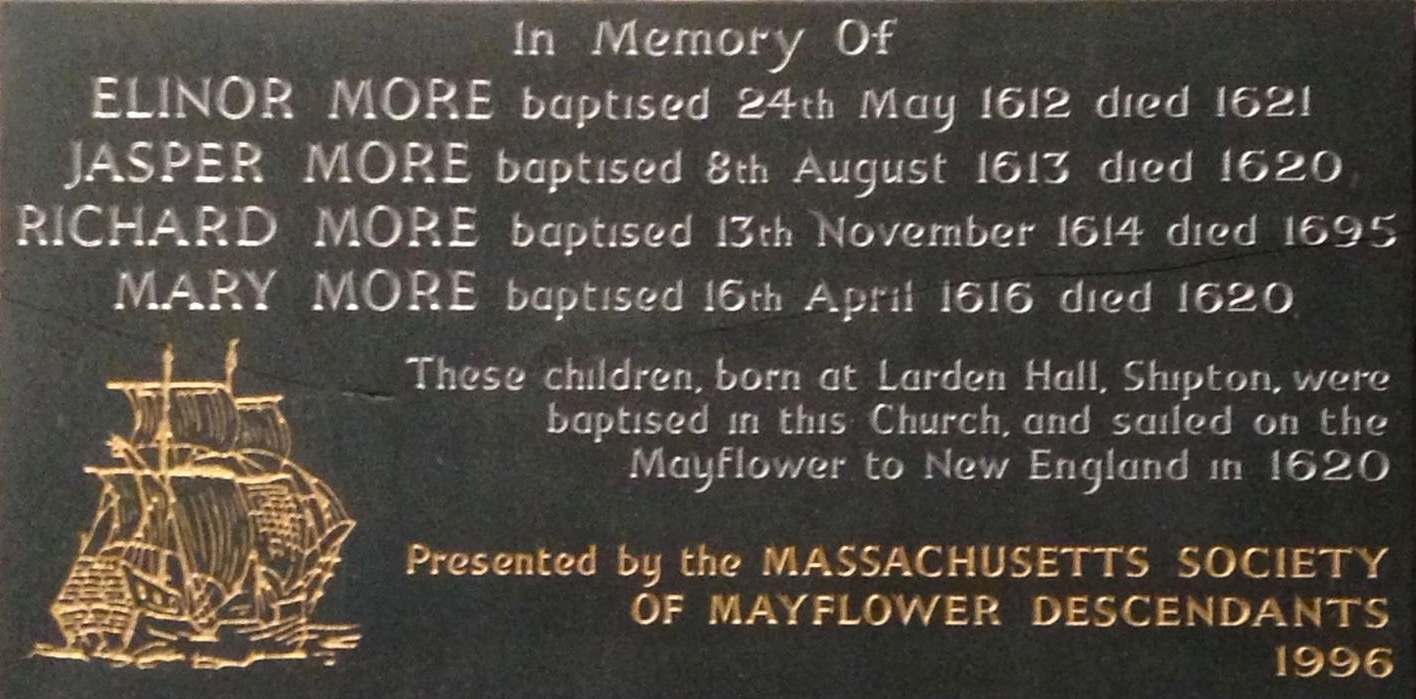Following the arranged marriage of Katherine and Samuel More in February of 1611, the couple lived at Larden Hall along with Katherine’s parents Jasper and Elizabeth. However Samuel often was away in London where he worked for Edward la Zouche, 11th Baron Zouche. As head of the Privy Council and a commissioner for The Virginia Company, Lord Zouche had a reason and the authority to put indentured child labor onboard ships bound for the New World.
Between February 1611 and April 1616 Katherine had four children, all baptized at St.James church in Shipton where today a plaque commemorates them:
- Elinor
- Jasper
- Richard
- Mary (aka Mae – my Grandmothers middle name)

By early spring of 1616, while Katherine was still pregnant with her youngest child Mary, Samuel More was about to assume control of both Linley and Larden estates from his father Richard. He then finally confronted Katherine with an accusation of adultery. It was apparent that none of the children looked like him, instead they particularly resembled Jacob Blakeway, who was from a common yeoman farming family that for years had leased land from Katherine’s Father Jasper. In Samuel More’s 1622 account of what happened, he described Jacob Blakeway as: ‘a fellow of meane parentage and condicon‘.
The Blakeway family were from Brockton. They had a leaseholder relationship with the Larden Mores for about thirty acres and held land between the Brockton crossroads and the River Corve over three generations. The original Blakeways came from a settlement over the Wenlock Edge. Blakeway Hollow leads out of Wenlock, and drops over the Edge to Apedale, where there is still a Blakeway family farm today.
Upon being confronted, Katherine admitted the children were not Samuel’s, but rather that Jacob Blakeway was in fact the biological father and that she had a previously recognized betrothal marriage contract with him. On June 14th 1616 she traveled to Hereford and appeared before the diocese Chancellor Oliver Lloyd seeking permission to divorce Samuel, but because she could not produce just two witnesses to her marriage with Jacob, it was not granted.
Katherine’s justification for divorce was a pre-contract formal betrothal with Jacob, prior to her arranged marriage to Samuel. Instead she was brought before the Court of the High Commission along with Jacob to formally confess her guilt and was fined £20. Furthermore, Jacob had to vow not to continue his relationship with Katherine.
Around this time, Samuel cut the entail off the estate, ensuring that none of the children would ever be able to inherit anything from the More family. He immediately took all four children from Katherine and then went to London to discuss the scandal with his employer Lord Zouche.
For the next four years the children were kept from their mother and forced to live in the care of servants at Linley Hall. While Katherine pursued the case to the Court of Audience and the ultimate court of appeal for ecclesiastical cases, the Court of Delegates. She repeatedly tried to be with her children to no avail and as Samuel testified; “In a hail of murderous oaths, she did teare the cloathes from their backes…”
Samuel claimed that Jacob continued to live with Katherine at Larden Hall after the children were removed, in defiance of the court ruling prohibiting him from having a relationship with her. Samuel and his father Richard then attempted to have Jacob forcefully removed from Larden Hall. As he stated Jacob ‘insolently affronted the said Samuel’s friends … doing other enormities to the said Samuel’.
In 1618 Samuel More had Jacob Blakeway brought before Judge Peter Warburton of the Court of Common Pleas and charged with trespass. With Samuel being awarded £400 of a sum originally claimed of over £1000. Given that Jacob was from a modest farming family, he could not afford to pay such a civil settlement. An arrest warrant was issued for Jacob Blakeway as a fugitive from justice. If he were to be captured he possibly would have been hanged. Rather than face the charge, he disappeared from history, never to be seen again.
It was not until 1959, during a winter snowstorm when Sir Jasper More, a descendant of Samuel More, on encouragement from friend Sir Anthony Wagner, by chance found in the attic of Linely Hall, a 1622 document that detailed the legal disputes between Katherine More and Samuel More and what actually happened to the More children.





